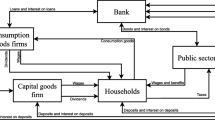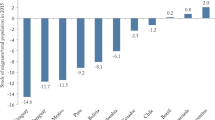Abstract
This paper presents a simple rule for optimal asymmetric labour taxation and subsidization in a two-sector model with logarithmic utilities and Cobb–Douglas production functions, linked to demographic factors: fertility rate and longevity. The paper shows that depending on whether the economy is dynamically efficient or inefficient, it may be optimal to tax or subsidize labour in the sectors. Under dynamic inefficiency, it is optimal to tax the investment-goods sector and a Pareto-improving tax reform is possible. Larger output elasticities of capital in the sectors reduce the possibilities of a Pareto-improving reform, while population ageing in terms of higher longevity enhances the possibilities of welfare improvement for all generations. Fertility rates do not affect optimal taxation. In appendix, we also address the cases of capital taxation/subsidisation and value-added taxes.


Similar content being viewed by others
Notes
We restrict our analysis to two overlapping generations because we intend to get analytical solutions and find an economic intuition for them.
We assume complete depreciation of capital since one period in a two-period OLG model is about 35 years.
As the effects of policies are examined in per-capita terms, it does not seem surprising that the population growth rate does not affect the optimal tax rate. However, n is important for comparison between our results and the golden rule.
References
Aaron H (1966) The social insurance paradox. Can J Econ Political Sci Rev Can Econ Sci Polit 32(3):371–374
Adema Y, Meijdam AC, Verbon HAA (2008) Beggar thy thrifty neighbour: the international spillover effects of pensions under population ageing. J Popul Econ 21(4):933–959
Andersen TM (2014) Intergenerational redistribution and risk sharing with changing longevity. J Econ 111(1):1–27
Anderson MW (2013) Intergenerational bargains: negotiating our debts to the past and our obligations to the future. Futures 54:43–52
Börsch-Supan A, Ludwig A, Winter J (2006) Ageing, pension reform, and capital flows: a multicountry simulation model. Economica 73(292):625–658
Breyer F (1989) On the intergenerational Pareto efficiency of pay-as-you-go financed pension systems. J Inst Theor Econ 145:643–658
Cremers ET (2006) Dynamic efficiency in the two-sector overlapping generations model. J Econ Dyn Control 30(11):1915–1936
Diamond P (1965) National debt in a neoclassical growth model. Am Econ Rev 55(5):1126–1150
Drugeon J-P, Nourry C, Venditti A (2010) On efficiency and local uniqueness in two-sector olg economies. Math Soc Sci 59(1):120–144
Epstein LG, Zin SE (1989) Substitution, risk aversion, and the temporal behavior of consumption and asset returns: a theoretical framework. Econometrica 57(4):937–969
Galor O (1992) A two-sector overlapping-generations model: a global characterization of the dynamical system. Econometrica 60(6):1351–1386
Galor O, Ryder HE (1991) Dynamic efficiency of steady-state equilibria in an overlapping-generations model with productive capital. Econ Lett 35(4):385–390
Geide-Stevenson D (1998) Social security policy and international labor and capital mobility. Rev Int Econ 6(3):407–416
Gollier C (2008) Intergenerational risk-sharing and risk-taking of a pension fund. J Public Econ 92(5–6):1463–1485
Gordon RH, Varian HR (1988) Intergenerational risk sharing. Journal of Public economics 37(2):185–202
Jensen BS (2003) Walrasian general equilibrium allocations and dynamics in two-sector growth models. Ger Econ Rev 4(1):53–87
Karabarbounis L, Neiman B (2014) The global decline of the labor share. Q J Econ 129(1):61–103
Maddison A (1987) Growth and slowdown in advanced capitalistic economies. J Econ Lit 25:647–698
Nourry C, Venditti A (2011) Local indeterminacy under dynamic efficiency in a two-sector overlapping generations economy. J Math Econ 47(2):164–169
Pestieau P, Racionero M (2016) Harsh occupations, health status and social security. J Econ 117(3):239–257
Phelps E (1961) The golden rule of accumulation: a fable for growthmen. Am Econ Rev 51(4):638–643
Reichlin P (1986) Equilibrium cycles in an overlapping generations economy with production. J Econ Theory 40(1):89–102
Samuelson PA (1958) An exact consumption-loan model of interest with or without the social contrivance of money. J Polit Econ 66(6):467–482
Selim S (2009) Optimal capital income taxation in a two sector economy. In: Duffy D, Shinnick E (eds) Public good, public policy and taxation: a European perspective, 4 in new developments in economic research. LIT, Berlin
Selim S (2010) Optimal taxation in a two sector economy with heterogeneous agents. Econ Bull 30(1):534–542
Selim S (2011) Optimal taxation and redistribution in a two sector two class agents’ economy. Cardiff economics working papers, Nr. E2011/6
Uzawa H (1961) On a two-sector model of economic growth. Rev Econ Stud 29(1):40–47
Uzawa H (1963) On a two-sector model of economic growth II. Rev Econ Stud 30(2):105–118
Venditti A (2005) The two sector overlapping generations model: a simple formulation. Res Econ 59(2):164–188
Verbon HA (1989) Conversion policies for public pensions plans in a small open economy. In: Gustafsson B, Klevmarken N (eds) The Political Economy of Social Security. Elsevier Science, Amsterdam
Author information
Authors and Affiliations
Corresponding author
Ethics declarations
Conflict of Interest
The author declares that he has not received any grant, honoraria or financial support (apart from the official salary). The author declares that he has no conflict of interest.
Appendices
Appendix 1: derivation of equation (24)
1.1 Utility maximization
We plug Eqs. (22) and (23) into the utility function (7), and differentiate it with respect to \(\tau _I\). As Eqs. (22) and (23) contain three multipliers depending on \(\tau _I\), it is convenient to express the first order condition in the following form:
where
and
After a number of simple algebraic manipulations we get that \(\partial D4 / \partial \tau _I=0\). Hence, \(D_3=0\). Substituting \(D_1\) and \(D_2\) into equation (28), the derivation of equation (24) is straightforward.
1.2 \(Y_C\) maximization
Instead of \(Y_C\) maximization in respect to \(\tau _I\), it is more convenient to maximise \(\log {Y_C}\), which gives an identical result, because logarithmic function is a strictly increasing function on the interval \((0,\infty )\). The first order condition is:
\(\partial \log {L_C}/\partial \tau _I\) can be easily found from Eqs. (14) and (17). \(k_C\) is given by Eq. (12), it depends on \(\tau _I\), \(\tau _C\) and \(k_I\), and the last two variables depend on \(\tau _I\) themselves. As \(\partial D4 / \partial \tau _I=0\), it is easy to see that \(\partial k_I / \partial \tau _I=0\). Hence, Eq. (31) simplifies to
Denominators of the first and the third fractions can be simplified. Furthermore, these fractions can be combined together. Then, the derivation of Eq. (24) is simple.
Appendix 2: Proof of proposition 1
Proof
Suppose that \(r^*=n\). Then, Eq. (25) can be rewritten as
As it is assumed that \(n>-1\), \(\alpha \rho +\beta \psi +\alpha =\psi (1-\alpha )\) and condition (27) holds.
If we assume that (27) holds, Eq. (25) can be rewritten as
Hence, the nominator of the second term in the right hand side of Eq. (33) is equal to zero, i.e., \(\alpha \rho +\beta \psi +\alpha =\psi (1-\alpha )\) and condition (27) simplifies to \(r^*=n\). \(\square \)
Appendix 3
1.1 Capital taxation
When capital is taxed instead of labour, the real interest rate, which affects consumption when old (Eq. 9) changes to: \(1+R_x(t)=(1+r_x(t))(1-\tau _x)/\psi \), \(x\in \{I, C\}\); labour market equilibrium is given by an equality of wages in the sectors: \((1-\alpha )k_C^\alpha =p(t)(1-\beta )k_I^\beta \); capital market equilibrium is given by an equality of net capital incomes: \(\alpha k_C^{\alpha -1}(t)(1-\tilde{\tau }_C)=p(t)\beta k_C^{\beta -1}(t)(1-\tilde{\tau }_I)\), where \(\tilde{\tau }_x\), \(x\in \{I,C\}\) denote sector-specific taxes. Dividing labour market equilibrium by capital market equilibrium we get
Equation for savings (10) changes to
leading to a different expression for share of agents working in the investment-good sector:
Equalizing total savings in the economy to the amount of capital, we get an expression for capital–labour ratio in sector I:
Expression for government budget balance (21) changes as well. Now government budget is balanced when \(K_C (1+r_C) \tilde{\tau }_C=- K_I (1+r_I) \tilde{\tau }_I\), implying that
Having derived capital labour ratios and government budget constraint, we solve for the other variables and maximize the utility functions. We received the same optimal tax for the investment goods sector as in (24); however, taxes for the consumption goods sector are slightly different (compare Eqs. (21) and (38)).
1.2 Value added taxes
If VAT taxes are analysed instead of labour taxes, Eqs. (1–11) do not change; however, in equation (9) \(R_x(t), x\in \{I, C\}\) changes to \(1+R_x(t)=(1+r_x(t))(1-\tau _x)/\psi \), which does not affect savings.
Capital market equilibrium changes to
As a result, Eq. (12) simplifies to
Equations (17)–(18) do not change, but Eq. (20) changes to
Government budget constraint changes to \(Y_C(t)\tau _C=-p Y_I \tau _I\) resulting in
Having derived capital–labour ratio and government budget constraint, we express all the other variables of interest. We have two opportunities: to maximize agents’ utilities with respect to \(\tau _I\) directly, or to maximize \(Y_C\). In contrast to the cases of separate labour and capital taxation, these two methods do not give the same results, because agent’s income is taxed/subsidized twice: first it is taxed/subsidized when young agents receive their wages; next, the income of the old generation is taxed/subsidized. Therefore, a part of the tax for the young, working in one sector, returns as a subsidy for the old, invested to another sector, or vice versa. This produces an intergenerational reallocation of income, comparable to a pay-as-you-go pension scheme and such a reallocation mechanism affects agents’ budget constraints in a way different from separate labour or capital taxation/subsidization.
Indeed, direct maximization of agents’ utilities has not given us an analytical solution. But it can be made numerically. For example, for parameter values used in Sect. 5 we received \(\tau _I=10.76\%\), \(\tau _C=-\,4.41\%\) for the case \(\alpha =0.2\) and \(\tau _I=-\,26.64\%\), \(\tau _C=8.63\%\) when \(\alpha =0.3\).
The government may choose to maximize \(Y_C\). Then, the optimization problem gives \(\tau _I\) exactly as in the case of labour taxation (Eq. 24), and \(\tau _C\) is given by Eq. (42). For the parameter values used in Sect. 5 this results in \(\tau _I=14.20\%\), \(\tau _C=-\,5.84\%\) for the case \(\alpha =0.2\) and \(\tau _I=-\,11.06\%\), \(\tau _C=5.97\%\) when \(\alpha =0.3\). Intuitively, it is clear, that if \(Y_C\) is maximized, the government may reallocate consumption goods with lump-sum taxes and subsidies in such a way, that consumption of all the agents increases after an introduction of such a tax, resulting in a higher utility level.
Rights and permissions
About this article
Cite this article
Fedotenkov, I. Optimal asymmetric sector-specific labour taxation in an overlapping generations model. J Econ 127, 1–18 (2019). https://doi.org/10.1007/s00712-018-0625-1
Received:
Accepted:
Published:
Issue Date:
DOI: https://doi.org/10.1007/s00712-018-0625-1




